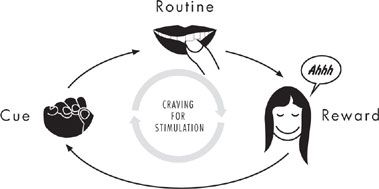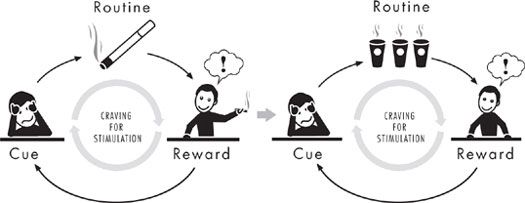The Power of Habit: Why We Do What We Do in Life and Business (14 page)
Read The Power of Habit: Why We Do What We Do in Life and Business Online
Authors: Charles Duhigg
Tags: #Psychology, #Organizational Behavior, #General, #Self-Help, #Social Psychology, #Personal Growth, #Business & Economics
In the summer of 2006, a twenty-four-year-old
graduate student named Mandy walked into the counseling center at
Mississippi State University.
3.22
,
3.23
For most of her life, Mandy had bitten her nails, gnawing them until they bled. Lots of people bite their nails. For chronic nail biters, however, it’s a problem of a different scale. Mandy would often bite until her nails pulled away from the skin underneath. Her fingertips were covered with tiny scabs. The end of her fingers had become blunted without nails to protect them and sometimes they tingled or itched, a sign of nerve injury. The biting habit had damaged her social life. She was so embarrassed around her friends that she kept her hands in her pockets and, on dates, would become preoccupied with balling her fingers into fists. She had tried to stop by painting her nails with foul-tasting polishes or promising herself, starting
right now,
that she would muster the willpower to quit. But as soon as she began doing homework or watching television, her fingers ended up in her mouth.
The counseling center referred Mandy to a doctoral psychology student who was studying a treatment known as “habit reversal training.”
3.24
The psychologist was well acquainted with the Golden Rule of habit change. He knew that changing Mandy’s nail biting habit required inserting a new routine into her life.
“What do you feel right before you bring your hand up to your mouth to bite your nails?” he asked her.
“There’s a little bit of tension in my fingers,” Mandy said. “It hurts a little bit here, at the edge of the nail. Sometimes I’ll run my thumb along, looking for hangnails, and when I feel something catch, I’ll bring it up to my mouth. Then I’ll go finger by finger, biting all the rough edges. Once I start, it feels like I have to do all of them.”
Asking patients to describe what triggers their habitual behavior is called awareness training, and like AA’s insistence on forcing alcoholics to recognize their cues, it’s the first step in habit reversal
training. The tension that Mandy felt in her nails cued her nail biting habit.
“Most people’s habits have occurred for so long they don’t pay attention to what causes it anymore,” said Brad Dufrene, who treated Mandy. “I’ve had stutterers come in, and I’ll ask them which words or situations trigger their stuttering, and they won’t know because they stopped noticing so long ago.”
Next, the therapist asked Mandy to describe why she bit her nails. At first, she had trouble coming up with reasons. As they talked, though, it became clear that she bit when she was bored. The therapist put her in some typical situations, such as watching television and doing homework, and she started nibbling. When she had worked through all of the nails, she felt a brief sense of completeness, she said. That was the habit’s reward: a physical stimulation she had come to crave.

MANDY’S HABIT LOOP
At the end of their first session, the therapist sent Mandy home with an assignment: Carry around an index card, and each time you feel the cue—a tension in your fingertips—make a check mark on the card. She came back a week later with twenty-eight checks. She was, by that point, acutely aware of the sensations that preceded her habit. She knew how many times it occurred during class or while watching television.
Then the therapist taught Mandy what is known as a “competing
response.” Whenever she felt that tension in her fingertips, he told her, she should immediately put her hands in her pockets or under her legs, or grip a pencil or something else that made it impossible to put her fingers in her mouth. Then Mandy was to search for something that would provide a quick physical stimulation—such as rubbing her arm or rapping her knuckles on a desk—anything that would produce a physical response.
The cues and rewards stayed the same. Only the routine changed.

MANDY’S NEW HABIT LOOP
They practiced in the therapist’s office for about thirty minutes and Mandy was sent home with a new assignment: Continue with the index card, but make a check when you feel the tension in your fingertips and a hash mark when you successfully override the habit.
A week later, Mandy had bitten her nails only three times and had used the competing response seven times. She rewarded herself with a manicure, but kept using the note cards. After a month, the nail-biting habit was gone. The competing routines had become automatic. One habit had replaced another.
“It seems ridiculously simple, but once you’re aware of how your habit works, once you recognize the cues and rewards, you’re halfway to changing it,” Nathan Azrin,
one of the developers of habit reversal training, told me.
3.25
“It seems like it should be more complex.
The truth is, the brain can be reprogrammed. You just have to be deliberate about it.”
2
Today, habit reversal therapy is used to treat
verbal and physical tics, depression, smoking, gambling problems, anxiety, bedwetting, procrastination, obsessive-compulsive disorders, and other behavioral problems.
3.26
,
3.27
And its techniques lay bare one of the fundamental principles of habits: Often, we don’t really understand the cravings driving our behaviors until we look for them. Mandy never realized that a craving for physical stimulation was causing her nail biting, but once she dissected the habit, it became easy to find a new routine that provided the same reward.
Say you want to stop snacking at work. Is the reward you’re seeking to satisfy your hunger? Or is it to interrupt boredom? If you snack for a brief release, you can easily find another routine—such as taking
a quick walk, or giving yourself three minutes on the Internet—that provides the same interruption without adding to your waistline.

If you want to stop smoking, ask yourself, do you do it because you love nicotine, or because it provides a burst of stimulation, a structure to your day, a way to socialize? If you smoke because you need stimulation, studies indicate that some caffeine in the afternoon can increase the odds you’ll quit.
More than three dozen studies of former smokers have found that identifying the cues and rewards they associate with cigarettes, and then choosing new routines that provide similar payoffs—a piece of Nicorette, a quick series of push-ups, or simply taking a few minutes to stretch and relax—makes it more likely they will quit.
3.28

If you identify the cues and rewards, you can change the routine.
At least, most of the time. For some habits, however, there’s one other ingredient that’s necessary: belief.
“Here are the six reasons everyone thinks we can’t win,” Dungy told his Buccaneers after becoming head coach in 1996. It was months before the season started and everyone was sitting in the locker room. Dungy started listing the theories they had all read in the newspapers or heard on the radio: The team’s management was
messed up. Their new coach was untested. The players were spoiled. The city didn’t care. Key players were injured. They didn’t have the talent they needed.
“Those are the supposed reasons,” Dungy said. “Now here is a fact: Nobody is going to outwork us.”
Dungy’s strategy, he explained, was to shift the team’s behaviors until their performances were automatic. He didn’t believe the Buccaneers needed the thickest playbook. He didn’t think they had to memorize hundreds of formations. They just had to learn a few key moves and get them right every time.
However, perfection is hard to achieve in football. “Every play in football—every play—someone messes up,” said Herm Edwards, one of Dungy’s assistant coaches in Tampa Bay.
“Most of the time, it’s not physical.
3.29
It’s mental.” Players mess up when they start thinking too much or second-guessing their plays. What Dungy wanted was to take all that decision making out of their game.
And to do that, he needed them to recognize their existing habits and accept new routines.
He started by watching how his team already played.
“Let’s work on the Under Defense,” Dungy shouted at a morning practice one day. “Number fifty-five, what’s your read?”
“I’m watching the running back and guard,” said Derrick Brooks, an outside linebacker.
“What precisely are you
looking
at? Where are your eyes?”
“I’m looking at the movement of the guard,” said Brooks. “I’m watching the QB’s legs and hips after he gets the ball. And I’m looking for gaps in the line, to see if they’re gonna pass and if the QB is going to throw to my side or away.”
In football, these visual cues are known as “keys,” and they’re critical to every play. Dungy’s innovation was to use these keys as cues for reworked habits. He knew that, sometimes, Brooks hesitated a moment too long at the start of a play. There were so many things for him to think about—is the guard stepping out of formation?
Does the running back’s foot indicate he’s preparing for a running or passing play?—that sometimes he slowed down.
Dungy’s goal was to free Brooks’s mind from all that analysis. Like Alcoholics Anonymous, he used the same cues that Brooks was already accustomed to, but gave him different routines that, eventually, occurred automatically.
“I want you to use those same keys,” Dungy told Brooks. “But at first, focus only on the running back. That’s it. Do it without thinking. Once you’re in position,
then
start looking for the QB.”
This was a relatively modest shift—Brooks’s eyes went to the same cues, but rather than looking multiple places at once, Dungy put them in a sequence and told him, ahead of time, the choice to make when he saw each key. The brilliance of this system was that it removed the need for decision making. It allowed Brooks to move faster, because everything was a reaction—and eventually a habit—rather than a choice.
Dungy gave every player similar instructions, and practiced the formations over and over. It took almost a year for Dungy’s habits to take hold. The team lost early, easy games. Sports columnists asked why the Bucs were wasting so much time on psychological quackery.